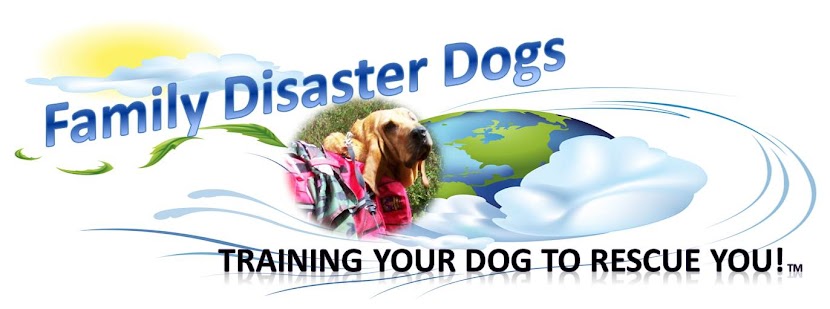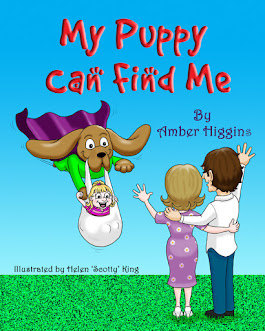How to Train a Tracking Dog
Most of the
lessons at Family Disaster Dogs, so far, have focused on teaching your dog on how to find a missing
person by air scenting or trailing not “tracking.” This lesson will explain to you how to teach
your dog to be a tracking dog that follows each step of a person or the exact
path the person traveled.
This lesson
can be used to start any dog on tracking for any reason, including AKC tracking
titles and other dog club tracking events, law enforcement and SAR.
This lesson
is fun for Family Disaster Dogs and other service dogs to do with their family
members at the park or playground, and then in the event of a lost family
member your dog will be able to track them down without any other training.
First, let’s
go over the differences between a tracking and trailing or air scenting
detection dog.
A tracking
dog follows the exact footprint scent on the ground that is left behind as a
person walks while a trailing or air scenting dog follows the scent as it
drifts on the wind.
Watch my dog find my daughter..is she tracking or air scenting? answer at bottom of page
You can tell
the difference when you watch your dog work by noticing if your dog is air
scenting by lifting its head above the ground, smelling high for a scent or
carrying their head over 6 inches off the ground. They will seek the scent on
the wind and in the air while a tracking dog keeps its nose to the ground and
concentrates their focus within about 6 inches of the ground.
You can hear a tracking dog huffing on the ground;
a bloodhound will blow the dust away when they are getting into the scent but
when they are air scenting they hold their heads high, nose up seeking. When
the scent is found, they are off, nose and head about body height with tail
wagging.
When they
put that nose into the ground and snort, seek and run with the nose as close to
the ground as it seems they can they have switched to tracking for air
scenting.
In dog club
events, the difference can cost your dog points towards a title. In search dog
work, it only matters that you learn to read your dog and find the person in
the swiftest safest manner.
Many people
find training a dog to do air scenting or trailing easier then training a
tracking dog. For this reason, I covered air scenting and trailing dog training
first to give you a better understanding of the fundamentals of detection dogs
in order for this lesson to be easier for you and your dog or the novice
tracking dog trainer.
I’ve been training
tracking dogs since the 70’s and worked at K9 of Hawaii in 1978 to further my
education of security dog work. This method is well proven to work with any
breed of dog.
Equipment
needed:
1 Dog
A person to
hide from the dog, known as the “Trail or Track Layer”
20 ft
Tracking Leash and Harness
Several
pieces of tissue papers or 12 small plastic flags that are used at building
sites and available at hardware stores
Small bite
size dog treats
A large
outdoor mowed grassy area; for instance, a quite corner of a city park away
from distractions, a school ground or open grassy mowed field.
Preplanning:
Read these
lessons
What to do First
Discuss with
the Trail Layer how they will make the footprint track for your dog to learn
on. Tell them they will be starting at the spot you choose in the grass and
they will be placing one tissue paper or flag with a dog treat at this spot,
then they will scruff and slide their feet on the ground to shuffle as they
walk the first 3 or 4 steps of the trail.
They will drop a few dog treats
exactly where they scruff their feet as they walk away from you.
Your dog can
watch this part of the lesson either sitting next to you or tied close by.
This
scuffing the ground will help to disperse more scent at the starting point and
the trail layer will do this shuffle scuff walk on each corner for the first
few lessons until your dog understands they are looking for human scent. Once
your dog starts tracking without hesitation you can have the trail layer walk
normally when they make a course for your dog to follow.
After the
starting point, the trail layer will walk in a straight line into the direction
of the wind blowing, if there is a breeze you can feel. The person will bend
over to place a piece of tissue with a dog treat or a flag and treat every 10
steps or so for the length of the course. The person should keep a treat to
give the dog when they welcome them at the end of the course.
After 50 ft (steps) or so, the person will either sit
behind a tree or the corner of a building, or lay down flat on the grass. We
don’t want the dog to have sight of the person but we do want the person in an
easy to find spot where they can step out and welcome the dog.
Do not add a
corner to the course until your dog is tracking the person successfully on a
straight line course. When you add a corner, only add one turn at a time per
lesson per day to avoid confusing the dog. Tracking is a gradual training process
that should not be rushed.
Once the
person has laid the course and trail your dog will follow you get your dog and
point to the starting flag. Tap the ground at the dog treat, foot print spot to
show your dog the exact scent you want them to follow. Ask your dog to “Smell”
or “Take Scent”.
Give your
dog all the time they need to smell and when their head raises up from the
ground be ready to command “Track” or “Find them” and step off with your dog on
the path the person took.
As your dog
moves ahead in the direction of the person repeat the “find” command and allow
your dog time to do what you ask. If they do not move ahead on the course then
prompt them with praise and encouragement as you slowly walk and point down on
the path. You may have to point and tap the ground a few times to keep your dog on the scent until they realize what you are doing.
As you follow the person’s trail your dog will find the dog treats
covered in the person’s sent along with the flags and scuff marks or pool scent
areas. This will encourage your dog to seek the scent and person.
When you
reach the person, praise your dog and have the person welcome them with petting
and give them a dog treat.
Repeat the
same exact course again. Do not change anything.
 |
| Amber working Sam |
As you repeat this the dog learns to follow the scent of the foot prints. As your dog learns you will use less treats and more praise until eventually and gradually you replace the food treats with praise only. from then on your dog only gets a food treat when they find the person otherwise you will be teaching your dog to find food. Which we do not want.
Do this same
exact lesson and course 3 or 4 times each day for 3 days then give your dog a
day or 2 off to think about this new game they have learned. Read the lesson
about Burning out your dog to familiarize yourself with this aspect of training
a working dog.
Repeat this
lesson for a couple of weeks then add a corner and be sure the trail layer
scruffs their feet, drops a dog treat and flags the corner.
The flags are placed on the course for you to
see the corners and lay of the trail before your dog reaches them in order for
you to know your dog is on the right course.
These flags
or tissue paper will also give you confidence to trust your dog because as you
work with your dog on tracking you will see how amazing the nose can be.
After a
couple of weeks with one corner then add another turn so there are 2 corners or
turns on the course. Keep the course about 100 ft long until your dog has the
hang of tracking.
Train on nice, mild not breezy days when the weather is not
to hot. If the weather is hot, train in the early morning or evening when the
day cools down for better performance.
There will
be more discussion about weather and performance in the coming lessons about
variables of a search scene.
In a few
weeks and once your dog is tracking the person’s trail as outlined
successfully, and only then, you can use a different person and change people
every couple of days.
You do not want to change people the same day or use more
then one person a day while training a novice tracking dog until the dog
totally understands what you want them to do.
You will know by watching your
dog when this happens. You will feel a great deal of accomplishment when you
realize your dog is doing this!
You will be like, “oh wow, look what my dog can do!”.
At this
point, which can take a month or so, and only after this point is when you can
add other people, and you can start aging the trail too.
When you age
the trail the dog learns to find a person who has been missing longer lengths
of time, such as somebody who is missing 8 hours.
The dog first has to learn
what the scent smells like 15 minutes later then when the person walked there,
then 30 minutes, then 1 hour and up to 48 hours later.
Therefore,
when you are training dogs that will be looking for people and not doing
tracking events for titles, the dog has to learn how to tell the time and age
of the trail in order to work a scene where the person has been missing for
several hours or a day.
Dogs do tell time very well when we pay attention.
Whereas, if
your dog is not going to be looking for lost people then you can skip the part
about aging a trail or adding extra people. You can use an object, like a toy
for your dog to find and you can use yourself as the trail layer.
Go to the Lessons page to learn how to train your dog to track you and much more !Including how
to get a reluctant tracker to work.
Have fun and
happy trails with your dog!
answer: My dog is video above is tracking and trailing, she is working the foot scents of the person























